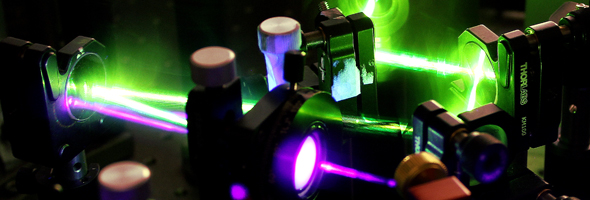
Perovskite materials are the newest contender for breaking the silicon ceiling in solar cell technology. But they don’t just absorb light. Cambridge researchers have found they emit it like a laser, opening up an entirely new field of applications.
Perovskite materials are the newest contender for breaking the silicon ceiling in solar cell technology. But they don’t just absorb light. Cambridge researchers have found they emit it like a laser, opening up an entirely new field of applications.
This feels like it’s the dawn of a new field. So far we’ve looked at the materials as they are. The question now is how good will they be?
Professor Sir Richard Friend
Discovered 175 years ago in Russia’s mineral treasure box – the Ural Mountains – and named after the mineralogist Count Lev Aleksevich von Perovski, perovskite is fast becoming a ‘rock’ to be reckoned with. In 2013, the use of perovskite materials in solar cells was voted as one of the breakthroughs of the year by Science magazine; more recently, the Guardian website declared that they “are the clean tech material development to watch right now.”
Perovskite is a term used to describe a group of materials that have a distinctive crystal structure of cuboid and diamond shapes. They have long been of interest for their superconducting and ferroelectric properties. But, in the past five years, it was discovered that they are also remarkably efficient at absorbing photons of light and that this can be converted into an electric current in photovoltaic solar cells.
A defining moment came in 2012, when Professors Henry Snaith at the University of Oxford and Michael Graetzel at the Federal Institute of Technology Lausanne, building on the work of Tsotomu Mayasaka from Tokyo, found that solar cells with perovskite as the active component could be made with greater than 10% power conversion efficiencies for turning the sun’s rays into electrical energy. A mere two years later, Snaith increased this to 17%. For silicon-based solar cells, it’s taken 20 years of research to achieve this level.
Now, researchers in Cambridge have found another property of this remarkable material – it doesn’t just absorb light, it also emits it as a laser.
Led by Professor Sir Richard Friend from the Department of Physics, the researchers have been investigating how perovskites work by exciting the material with light and monitoring energy absorption at incredibly fast timescales, taking ‘snapshots’ a few quadrillionths of a second apart.
As PhD student Michael Price described: “This enables us to monitor directly what is happening to the electrons, which generate the current in the material – where the excitations are and how they are destroyed, essentially how fast they live and die.”
In collaboration with Snaith’s group in Oxford, the scientists are using this fundamental insight to help them understand how the efficiency of perovskite-based photovoltaics might be extended yet further.
The lasing properties (published in the Journal of Physical Chemistry Letters in March) were discovered when Friend’s team measured the photoluminescence efficiency of the material, and found that up to 70% of absorbed photons were emitted under the right conditions. This led to the idea of sandwiching a thin layer of the lead halide perovskite between two mirrors to create an optically driven laser.
“It turns out that perovskites are remarkably fluorescent materials,” explained Friend. This is not in itself a surprise – since the early 1960s a relationship between the generation of electrical charges following light absorption and the process of ‘recombination’ of these charges to emit light has been known. “But these materials do so very efficiently,” said Friend. “It’s unusual in a material that is so simply and cheaply prepared.”

“Mix and squirt,” is how Price described the preparation process: “we make a solution of the halide perovskites and spin- coat them onto an electrode. There’s no need for elaborate purification.” This simple process, which the scientists say is scalable, is in contrast to the painstaking growth of crystals needed for other solar cell materials like silicon to ensure that the number of defects in the materials is kept as low as possible.
“Perovskites are cheap and abundant, they are easily fabricated and they have a high efficiency of energy conversion – these three together are the holy grail of photovoltaics, which is why there is such excitement about them at the moment,” added Dr Felix Deschler.
The lasing properties of perovskites raise expectations for even higher solar cell efficiencies, as Friend explained: “There’s a fundamental relationship between how good a material is at emitting light and how well it works in a solar cell.”
The team’s work is based on a programme of research on organic (i.e. carbon-containing) semiconductors that has spanned over 20 years in Friend’s laboratory, most recently as part of the Winton Programme for the Physics of Sustainability, and has resulted in the development of roll-to-roll printing of photovoltaic materials, light-emitting diodes (LEDs) and printed transistors for paper displays. The techniques Friend’s group has developed for characterising organic semiconductors are now being deployed on the mostly inorganic perovskite materials.
The current focus is on identifying the fundamental mechanisms that are at play when photons of light raise electrons in the material to higher energy states, and on looking at precisely how and where energy losses occur – an understanding of which will be crucial to maximising the efficiency of these light-harvesting solar cells.
Intriguingly, early results show that the material doesn’t appear to work in the way that might be expected. “For me, the excitement is that these materials break the rules,” said Friend. “Many of their properties are somewhere between those of an organic and an inorganic semiconductor. The way we make them, they should have too many chemical and structural defects to work as well as they do and yet they are as efficient as purified silicon, which is a single crystal.”
Would they be better if cleaned up? “Possibly,” said Friend, “but we want to have our cake and eat it. We want the efficiencies and the ease of preparation.”
Defects in materials normally cause charged electrons to get ‘stuck’ and lose their energy. One possibility for perovskites might be that the defects don’t matter because the material has the capacity to ‘self-heal’.
“There’s something going on... these materials have a tolerance to disorder
which is unusual,” explained Friend. “It’s speculation, but perhaps the material can fill defects on the fly. The way the material is prepared creates a lot of free ions, and these might move around and fill up defects. Imagine a bumpy road with potholes – the ions might fill the potholes and then the electrons have a smooth ride.”
A better understanding of these processes will feed into the collaboration with Snaith’s group, helping the scale-up and commercial deployment of perovskite-based photovoltaics through the Oxford spin-out Oxford Photovoltaics.
Meanwhile, the Cambridge team is also pursuing the material’s light-emitting properties, as Deschler explained: “It opens up a completely new field of applications. The laser industry is huge – they are used in areas that are critical for our lives, including telecommunications, medicine and industry. We think there will be applications for perovskites that extend far beyond the solar cell.”
In particular, the researchers are now looking at applying the high luminescence efficiency to create light-emitting diodes. Other members in the research group have already had some very promising results in this area, which should be published soon.
“This feels like it’s the dawn of a new field,” said Friend. “So far we’ve looked at the materials as they are. The question now is how good will they be?”
The text in this work is licensed under a Creative Commons Licence. If you use this content on your site please link back to this page. For image rights, please see the credits associated with each individual image.





